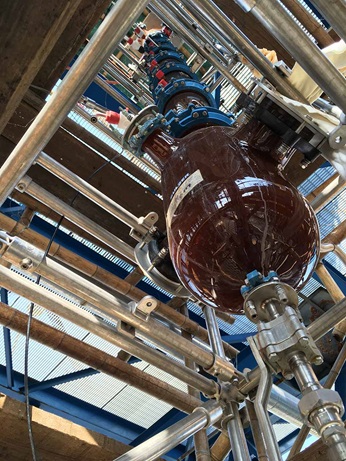Media release
January 19, 2021Sulzer Chemtech develops circular system for leading sebacic acid manufacturer
Widely used for the production of a broad range of industrial products, such as plasticizers, candles, lubricants, hydraulic fluids and resins, sebacic acid has been in high demand over recent years. Currently, its synthesis mostly relies on castor oil, which is a bio-based, renewable raw material, as the substance is extracted from Ricinus communis’ seeds. This green aspect is one of the main reasons why sebacic acid production dominates castor oil’s industrial use, particularly in China - the second largest producer of this oil.
One of the most common synthetic routes to obtain sebacic acid involves the hydrolyzation of castor oil to obtain ricinoleic acid, which then undergoes an alkali fusion/cracking in the presence of phenol and sodium hydroxide (NaOH). Once sebacic acid is purified, the resulting wastewater contains large quantities of the initial phenolic compound used.
Being a contaminant, phenols should be removed from wastewater and properly disposed of. If the concentration of the organic compound is particularly high, the effluents are recalcitrant to conventional biological treatments in wastewater facilities. Therefore, it is important for production facilities to conduct phenol extraction activities prior to discharging the effluents. Furthermore, manufacturers should also look at methods to recover or recycle phenol in their processes.
A revolutionary phenol recovery system
This was the goal of a leading sebacic acid producer in China, which wanted to reduce the volume of phenol in its wastewater from 1’000 ppm to 300 ppm while reusing the chemical multiple times for alkali fusion/cracking. The company aimed to reduce its environmental footprint as well as lowering its costs for consumables, as less virgin phenol would be required. To deliver a suitable wastewater purification/phenol recovery system, the manufacturer contacted Sulzer, the leader in separation and mixing technology.
Thanks to its extensive experience in processing technology, the company’s team was able to develop an innovative liquid-liquid extraction solution to address the needs of the sebacic acid manufacturer. This relies on ricinoleic acid as a key solvent to remove phenol from wastewater. The extracted compound would then be suitable for reuse in the alkali fusion/cracking stage, creating a sustainable, circular process. By doing so, the producer would also reduce the costs associated with solvent use as well as energy usage and equipment needed for solvent recovery, maximizing the environmental and financial benefits.
The equipment selected to conduct the liquid-liquid extraction was the Kühni agitated column (ECR), which is ideal to efficiently separate phenol as well as offering a cost-effective and compact setup. In addition, the column supports continuous processing, maximizing throughput and energy efficiency.
The ECR is composed of a series of agitated compartments that disperse fine droplets of ricinoleic acid within the wastewater feed. As a result, phenol is isolated by the solvent from the liquid mixture. More precisely, turbine agitators installed in each compartment create a torus-shaped, rotary flow pattern and mix the liquid phases radially. In addition, perforated plates between each stage reduce back-mixing, enhancing the system’s separation performance.
Fine-tuning innovation
To make sure the solution would remove high volumes of phenol from the wastewater, Sulzer and the manufacturer conducted a number of tests and preliminary investigations. Firstly, a laboratory ‘shake test’ to assess the feasibility of the method as well as determining liquid-liquid equilibrium data at different pH. This investigation highlighted that a higher pH would result in a lower content of phenol extracted, while alkaline conditions would maximize the volume of recovered phenol.
Subsequently, on-site pilot-scale tests were conducted to fine-tune the solution to optimize the hydrodynamic behavior of the dispersed and continuous phases. Similarly, the team could assess the flooding boundary, rotation limit as well as the expected maximum capacity and separation threshold. During this investigation, the main challenge was handling the material, which is particularly viscous. To overcome this issue, Sulzer’s experts decided to heat the feed material prior to its ingress into the ECR, lowering the viscosity.
As a result of these tests, the optimum design of the ECR was defined. The resulting 30 m (98.4 ft) high column, with a diameter of 2.4 m (7.9 ft) was delivered to the customer. Sulzer’s specialists subsequently managed and supervised the erection and installation of the system as well as providing key assistance during start-up.
The column can process up to 77’000 liters of wastewater per hour and is even more effective than initially requested, as it can deliver phenol concentrations of 200 ppm, well below the original request of 300 ppm. The solution also provides high flexibility, as the plant can successfully operate with capacities ranging from 50% to 120%.
Your contact
Chemtech Division
Sulzer Management Ltd
